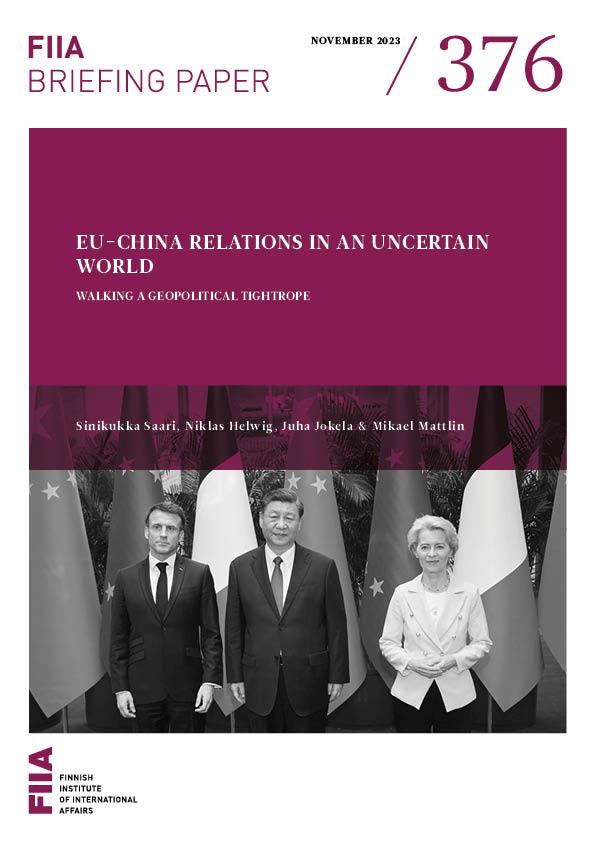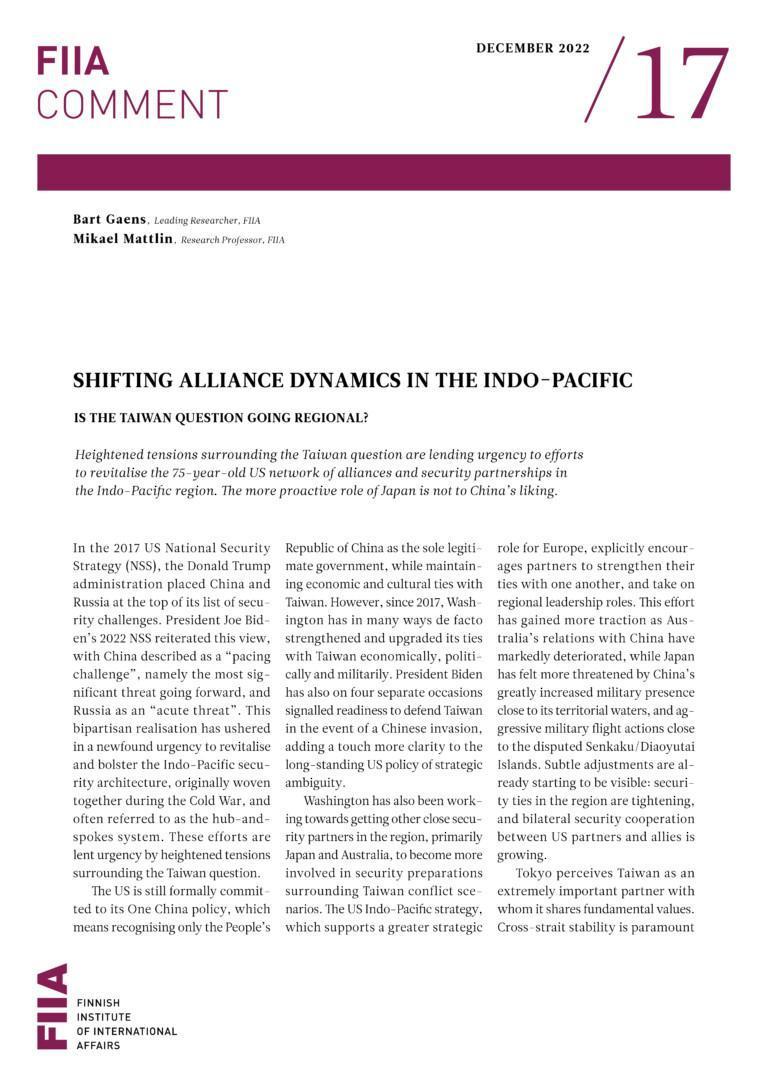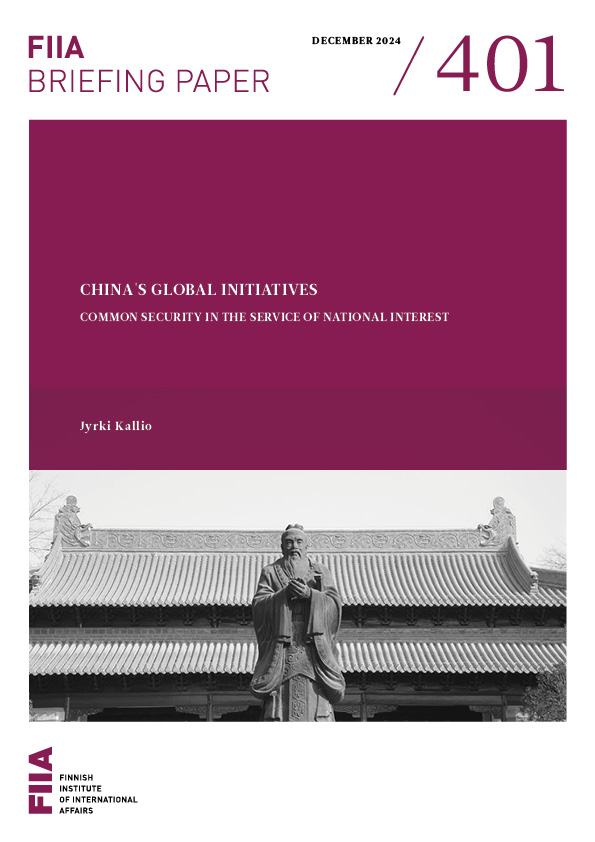At the end of 2022, Japan announced substantial changes to its defence posture with the publication of a new National Security Strategy, a National Defence Strategy, and a Defence Buildup Programme. These included a boosted defence budget and the addition of deterrence through counterstrike capabilities.
The policy shift is partly driven by the war in Ukraine, even if it can also be seen in the light of a much longer process of incremental changes. Furthermore, the new defence policy should be viewed in a broader context as part of Japan’s evolving multi-layered security strategy.
In addition to deterrence, other central pillars of this multi-layered strategy include coalition-building through alignment, Official Security Assistance for developing countries, a normatively pragmatic engagement with the Global South, and economic security.
Japan’s enhanced capabilities and increasingly proactive stance on coalition-building and alignment policy offer opportunities for cooperation, including with the EU and NATO. However, a more robust defence posture is offset by domestic challenges, including institutionalized self-imposed restrictions, political opposition, public opinion, economic and fiscal factors, and a greying population.
Introduction
On 16 December 2022, Japan launched its new National Security Strategy (NSS) – for the first time ever along with two other key documents, namely the National Defence Strategy (NDS) and the Defence Build-up Programme (DBP). The documents caused ripples in the Indo-Pacific region and beyond, not least due to the decision to raise the defence budget from 1% to 2% of GDP by proposing a 43-trillion-yen defence force development plan. The proclaimed goal to acquire counterstrike capabilities, a seeming shift away from Japan’s policy to only possess purely defensive weapons, raised eyebrows as well.
As in previous editions of the Security Strategy, Japan’s increasingly severe and complex regional security environment was cited as the backdrop for the defence policy changes. However, Russia’s war against Ukraine was certainly a major catalyst, for at least four reasons. First, the NSS explicitly stated that Russia’s aggression against Ukraine had breached the foundation of the international rules-based order. For Tokyo, it is clear that the forceful unilateral change to the status quo that is occurring in Europe could also happen in the Indo-Pacific region. Second, Russia’s increased military activities in the vicinity of Japan, and Moscow’s strategic coordination with China raised serious security concerns. Third, Japan drew the lesson that Ukraine's defence capabilities were insufficient and failed to discourage and deter Russian aggression. Finally, there was renewed awareness of the importance of cooperation with allies to deter and respond to external threats.[1]
This Briefing Paper assesses the significance of Japan’s new defence posture. It first describes the background to Japan’s shifting defence policy and the alliance with the US, after which it examines the context of multidimensional security marked by coalition-building and economic security. The paper argues that the shift in Japan’s policy needs to be seen in context, both by taking into account the longer time perspective and the broader scope of changing regional and global security dynamics.
The shift in defence policy: Japan’s Zeitenwende?
Some analysts call the shift in Japan’s defence policy the country’s own Zeitenwende. Domestically, conservative media hailed the new strategy for carving out “a realistic course for developing defence capabilities that correspond to the military capabilities of potential aggressors”. Polls indicated that a majority of respondents supported the idea of counterstrike capabilities. Liberal media, on the other hand, warned that the radical shift in security policy represented a dangerous turn, and criticized the shift to hard power. Some international observers interpreted the changes as marking a paradigm shift, a critical milestone in making Japan a “normal” country, or as the end of Japan’s pacifist post-war defence.
Japan’s goal to increase its defence budget from 27.4 to 43 trillion yen (roughly 300 billion USD) by fiscal 2027 is undoubtedly a milestone. Tokyo recently announced that the defence budget for fiscal 2024 would amount to a record 7.7 trillion yen (roughly 54 billion USD). Nevertheless, a few caveats should be considered. Japan’s defence budget has increased consistently over the past eleven years.[2] While the announced decision to raise the budget to 2% of GDP instead of the hitherto standard of 1% is important symbolically and has grabbed headlines, it needs to be kept in mind that it comprises all national security-related spending. The latter includes, for example, the Coast Guard budget, certain expenditure on public infrastructure for potential military use (such as airport runways), and private sector R&D.
If executed according to plan, the defence spending in fiscal year 2027 will be 60–65% higher than in 2022, which is significant but does not amount to an alleged “doubling of the defence budget” as reported by certain media.[3] Financing the planned increase will also be problematic in view of Japan’s high national debt, ageing population, opposition to tax increases, depreciating yen, and increasing prices of defence imports from abroad. To date, the government has not been able to fix the timing of tax hikes necessary to finance the defence spending surge.
Second, Japan will acquire counterstrike capabilities, with total costs amounting to 5 trillion yen, which would allow Tokyo to hit missile launch bases in other countries, following an enemy attack. In the short term, Japan would purchase 400 US-made Tomahawk cruise missiles starting in 2025, and in the longer term would aim to produce the missiles domestically. This is a major departure from the hitherto reliance on the US “spear” for counter-strikes, with Japan as the “shield” concentrating on missile defence systems. It would allow Japan “deterrence by denial”, meaning fostering an environment in which any Chinese attempts to change the status quo are unlikely to succeed.[4] This plays a complementary role to “deterrence by punishment”, referring to the US’s extended (or nuclear) deterrence.
Yet, when viewed from a longer perspective, it is another part of an extensive period of gradual change and reinterpretations of Japan’s pacifist constitution, which renounces war and rejects the use of force as a means of settling disputes. For example, in 2014–2015, the administration of former Prime Minister Shinzō Abe decided to reinterpret the constitution to allow for collective self-defence. This was seen at the time as an equally significant overhaul, as it could potentially embroil Japan in a possible Taiwan crisis by coming to the aid of US forces. Strict self-imposed constraints on the potential use of missiles are still in place in the form of Japan’s three conditions for the use of force, namely a threat to Japan’s survival, no other appropriate means being available, and keeping the use of force to an absolute minimum. Technical challenges remain, as Japan will need to boost command and control capabilities as well as intelligence, surveillance, reconnaissance and targeting (ISRT) assets.[5]
In addition to being part of a longer process of shifting defence policy, the planned modifications are also in line with Japan’s alliance with the US. The aim of the changes is to strengthen the alliance by increasing interoperability, which has been a wider trend among US allies during the past decade. Strengthening the alliance entails simultaneously beefing up Japan’s own defence and deterrence, a process that started during Abe’s term and has continued under the current administration of Prime Minister Fumio Kishida.
Paradoxically perhaps, reinforcing Japan’s position in the alliance with the US increases the country’s capabilities and autonomy in terms of defence. This is an additional step away from what Abe referred to as the post-war regime, namely Japan’s subservience to the US. Even so, Japan’s posture remains essentially defensive, and it is unclear, for example, to what extent Japan would be involved in a conflict over Taiwan in a situation where Japan itself is not under direct attack, what the US can do from its bases in Japan, or what Japan is legally able and practically willing to do in the event of a contingency.[6] In view of a potential second Donald Trump administration in the US, however, the planned changes do signal a more autonomous posture within the alliance, with a Japan that has vastly increased defence spending as well as tightened cooperation with the US defence industry, and that will in the long run be more capable of defending itself.
Evolving multi-layered security policy
Japan’s evolving security and defence policy should also be observed in the context of a multi-layered strategic response to changing regional dynamics. This includes China’s military modernization and increasingly assertive stance in the East and South China Seas, a possible Taiwan Strait contingency, and the threat posed by North Korea. Furthermore, Russia’s war of aggression in Ukraine and new anxieties over Moscow’s unpredictable demeanour have resulted in Japan’s ensuing turnaround as to its Russia policy. Tokyo was made acutely aware of the absence of prospects for Japan to achieve a deal over the Northern Territories (southern Kuril Islands) or to negotiate a peace treaty with Russia.
Coalition-building
In addition to defence, a second pillar of Japan’s security policy is coalition-building with likeminded partners, as well as with countries in the so-called Global South. Japan has aimed to strengthen bilateral ties with others, particularly through strategic partnership agreements, as of the early 2000s. In a region that still attaches prime importance to the idea of non-interference, strategic partnerships focusing on a limited number of issues have enjoyed particular popularity in the Indo-Pacific, serving as a highly flexible foreign policy instrument to promote cooperation in security, trade, or economic endeavours.
The alignment trend has gained importance in parallel with China’s growing clout, and is certainly visible in Southeast Asia. Japan has engaged in a comprehensive strategic partnership with the Association of Southeast Asian Nations (ASEAN), and the two celebrated fifty years of bilateral relations at a commemorative summit in December 2023. Particularly eye-catching was the deeper emphasis on security ties in the fields of capacity-building, defence equipment and technology, and joint training and exercises.
Southeast Asia is also an important region in terms of reeling in support from and cooperation with countries in the Global South. Unlike Japan, many developing countries as well as emerging powers have refused to condemn Russia’s invasion of Ukraine or align with Western sanctions. Nevertheless, engaging actors such as India and ASEAN countries is a crucial and explicit aim of Japan’s Free and Open Indo-Pacific (FOIP) strategic concept, which aims to preserve the liberal international order in the region based on shared values such as freedom, the rule of law and market economy. Since the start of the war in Ukraine, it has become clear that emerging powers and developing countries occupy a more prominent collective role and stronger voice in an increasingly post-Western world. Japan has been one of the most proactive players, paying more attention to the interests and views of countries in the Global South in order to offer an alternative to China in terms of trade but also security.
In so doing, Japan is emphasizing that it does not seek to preach or impose values. Japan is keenly aware that an over-emphasis on certain values can have an adverse effect, as counterpart countries may seek to engage with more pragmatically inclined countries such as China. It is no coincidence therefore that Prime Minister Kishida has proclaimed a “realism diplomacy for a new era” that seeks to avoid excluding anyone, creating camps, or imposing values. A pragmatic respect for diversity and different ways of thinking, rooted in a shared adherence to the rule of law, is therefore a core element of Japan’s revised FOIP plan, notably revealed in India in March 2023.
As a side note, this pragmatic stance was reflected in Japan’s reaction to the Middle East conflict between Israel and Hamas. Japan trod much more cautiously and diplomatically than in the case of Russia’s invasion of Ukraine. In the Middle East conflict, Tokyo presented a more neutral position in view of Japan’s reliance on crude oil from Arabic countries, as well as keeping in mind the stance of many countries in the Global South.
Notable in the context of alignment with developing countries in particular is the expanded use of foreign aid for security purposes. While this is not new and Japan has been implementing securitized Official Development Assistance (ODA) for some years now, this was always limited to coast guards, law enforcement agencies, maintenance and capacity-building. Under the new moniker Official Security Assistance (OSA), this has now been expanded to cover foreign armed forces as well.
In mid-November 2023, Japan and Bangladesh signed an agreement to boost the latter’s maritime security capabilities worth 575 million yen. Tokyo is providing assistance to the Philippines for coast guard vessels equipped with a radar system to the tune of 600 million yen. Deepening ties with Malaysia, Japan would provide 400 million yen (2.8 million USD) for warning and surveillance equipment. Another deal providing patrol boats has been signed with Fiji, and discussions with Vietnam for the provision of OSA are underway. While these amounts are modest, they have symbolic significance, showing Japan’s determination to try to deter China, secure critical sea lanes, and engage developing nations from the Global South, including by projecting soft power.[7]
Following changes in political leadership in both Japan and the Republic of Korea, and as a result of joint challenges such as North Korean missile launches and concerns over China, relations between Japan and South Korea have improved. Strongly promoted by the US, this thaw in relations culminated in the Camp David agreement in August 2023 on future trilateral defence cooperation. In October 2023, joint maritime and aerial drills were carried out together with the US, and in December 2023 the countries started a trilateral real-time system for sharing data on tracking North Korean missiles. Defence commitments and joint exercises have also increased at the bilateral level, through so-called Reciprocal Access Agreements (RAAs), including with Australia, the UK, and the Philippines.
Furthermore, the war in Ukraine has led to an increased awareness of a convergence of the European and East Asian security theatres. Japan, as well as South Korea, now aim to align themselves more with Euro-Atlantic politics by seeking closer alignment with NATO, and in complementing political dialogue with joint military exercises and capacity-building. The idea of a NATO liaison office in Tokyo, while apparently shelved for now, certainly testified to Japan’s conscious linking of the situation in Ukraine with a possible contingency in East Asia.
Defence equipment cooperation is another example of issue-based cooperation with likeminded partners. Together with Italy and the UK, Japan aims to develop a next-generation fighter aircraft through the Global Combat Air Programme (GCAP) by 2035, marking its first defence equipment development programme with countries other than the US. This, however, requires Japan to further revise its self-imposed restrictions on export rules for military equipment. In December 2023, Tokyo already relaxed defence export rules, facilitating joint research and development with allies and partners, and allowing it to export lethal defence equipment to countries that are not directly involved in combat operations.[8]
Economic security
The third important pillar of multi-layered security is economic security or promoting national interests by carrying out economic measures. This is generally seen as a reaction to economic statecraft by other countries, and in particular to the rise of China as a security threat and an economic rival. In 2022, as the first of the G7 countries, Tokyo passed the Economic Security Promotion Act, which seeks to strengthen supply chain resilience, protect critical infrastructure, and develop critical technologies and non-disclosure of patents for security reasons. In addition, the NSS announced additional measures for investment screening and export controls.[9] The recent focus on economic security marks a return to comprehensive security, which refers to a mix of military and non-military policies. Japan has de facto aimed to implement comprehensive security since the early post-war era, and effectively put it in place in the late 1970s, which at the time resulted in a policy of separating politics and economics (seikei bunri).[10]
The current focus on economic security entails efforts to reduce reliance on China, including restrictions on semiconductors and other critical technological components. It has led to the quest for strategic autonomy through friendshoring, or the diversification of supply chains among likeminded partners. This may imply a shift away from the policy of separating politics and economics. [11] However, at the end of the day, Japan – as well as South Korea for that matter – and China are highly interdependent economically. China is still Japan’s largest trading partner in merchandise to the tune of 300 billion USD annually (50% more than with the US), a vital investment destination, and an important source of components and materials. At a recent summit in November 2023, Prime Minister Kishida and Chinese President Xi Jinping seemed to acknowledge the need to improve economic ties, agreeing on a new framework for dialogue on trade. The willingness to focus on economic and trade relations, despite pervasive political quarrels, suggests that announcing the demise of the separation of politics and economic policy is premature.
Conclusions
In sum, Japan’s strengthened defence posture should be seen as part of an evolving multi-layered security policy. It enhances the security alliance with the US, but also takes small steps towards greater Japanese autonomy. This, in combination with a substantial increase in defence spending, is arguably also a means of at least partly pre-empting a more antagonistic stance by a potential new US administration under Donald Trump. The changes are certainly in line with Tokyo’s regional threat perceptions, only exacerbated by Russia’s war in Ukraine, but certainly continuously prompted by China’s incursions in the East China Sea and North Korea’s frequent missile launches. However, while increasing deterrence, Japan’s new defence policy also risks further fanning the flames of the military build-up by Japan’s rivals. There is consequently a need for dialogue, engagement, and trust-building measures. Favourable signs include the agreed-upon establishment of a defence hotline with China, and a possible forthcoming China-Japan-South Korea (CJK) summit following the Foreign Ministers’ meeting of November 2023, the first since 2019.
Furthermore, it should be kept in mind that, in view of Japan’s constitutionally-determined pacifist stance and institutionalised self-imposed restrictions, uncertainty remains as to what Japan can and is willing to do in the case of a contingency, for example over the Taiwan Strait. These uncertainties are exacerbated by domestic political and public opposition to drastic changes in military capabilities. The need for economic growth in a society with a rapidly shrinking working-age population further compounds the issue.
Lastly, Japan has taken a more proactive stance on coalition-building and alignment policy, including through relations with countries in the Global South. The war in Ukraine has also resulted in a convergence between European and Asian theatres, opening up opportunities for Japan to cooperate more with EU and NATO countries. Japan is already collaborating with NATO in cyber and countering hybrid threats. There has been convergence with Europe on economic security, and Japan’s focus on the Global South, particularly Africa, yields opportunities to flesh out the EU-Japan Partnership on Sustainable Connectivity and Quality Infrastructure. More than the EU perhaps, Japan has understood the importance of taking into account the words, deeds and priorities of emerging economies and developing countries as increasingly important players in today’s global politics.
Endnotes
[1] Japan’s Ministry of Defense. National Defense Strategy. 16 December 2022, p. 8. https://www.mod.go.jp/j/policy/agenda/guideline/strategy/pdf/strategy_en.pdf.
[2] Ochmanek, David A. et al. Inflection Point: How to Reverse the Erosion of US and Allied Military Power and Influence. RAND Corporation, 2023, p. 73. https://www.rand.org/pubs/research_reports/RRA2555-1.html.
[3] Liff, Adam P. No, Japan is not planning to double its defense budget. Brookings, 22 May 2023. https://www.brookings.edu/articles/no-japan-is-not-planning-to-double-its-defense-budget/. Alternatively, the rise amounts to 56% when comparing the 2019–2023 and 2023–2027 Defense Buildup Programme periods. See Choong, William. “Will Japan intervene in a Taiwan contingency? It depends”. The Japan Times. 17 December 2023. https://www.japantimes.co.jp/commentary/2023/12/17/japan/japan-taiwan-contingency/.
[4] Choong, William. “Will Japan intervene in a Taiwan contingency? It depends”. The Japan Times. 17 December 2023. https://www.japantimes.co.jp/commentary/2023/12/17/japan/japan-taiwan-contingency/.
[5] Yoshida, Kisho. “‘A key to deterring invasion’. Acquiring counterstrike capabilities is no simple matter”. The Japan Times. 14 December 2023. https://www.japantimes.co.jp/commentary/2023/12/14/japan/japan-counterstrike-capability/.
[6] Ochmanek, David A. et al. Inflection Point: How to Reverse the Erosion of US and Allied Military Power and Influence. RAND Corporation, 2023, p. 96. https://www.rand.org/pubs/research_reports/RRA2555-1.html.
[7] “With China in mind, Japan expands security ties with ASEAN”. The Japan Times. 18 December 2023. https://www.japantimes.co.jp/news/2023/12/18/japan/politics/japan-asean-security-cooperation-analysis/.
[8] For example, Japan would send Patriot missile defence stocks to the US to replace supplies sent to Ukraine. “Japan's Patriot-missile transfer to U.S. stuns Indo-Pacific watchers”. Nikkei Asia. 23 December 2023. https://asia.nikkei.com/Politics/International-relations/Indo-Pacific/Japan-s-Patriot-missile-transfer-to-U.S.-stuns-Indo-Pacific-watchers. However, whether Japan would be able to export the fighter jet developed jointly with the UK and Italy remains a topic of debate.
[9] European Parliamentary Research service. At a glance. Japan’s economic security legislation. July 2023. https://www.europarl.europa.eu/RegData/etudes/ATAG/2023/751417/EPRS_ATA(2023)751417_EN.pdf.
[10] Nakanishi, Hiroshi. “Redefining comprehensive security in Japan”. In Kokubun Ryôsei (ed.) Challenges for China-Japan-US Cooperation, 1998. Tokyo: Japan Center for International Exchange.
[11] Nagy, Stephen. “Kishida’s diplomacy pushes back on seikei bunri”. East Asia Forum. 12 October 2023.









